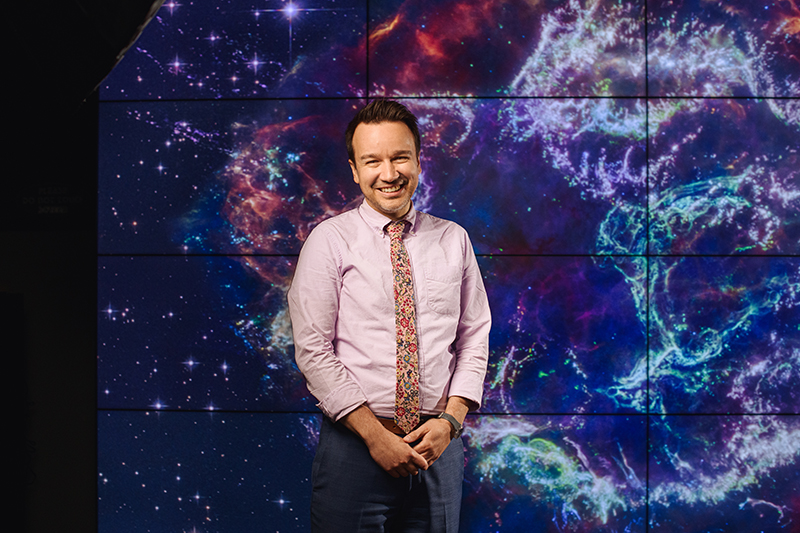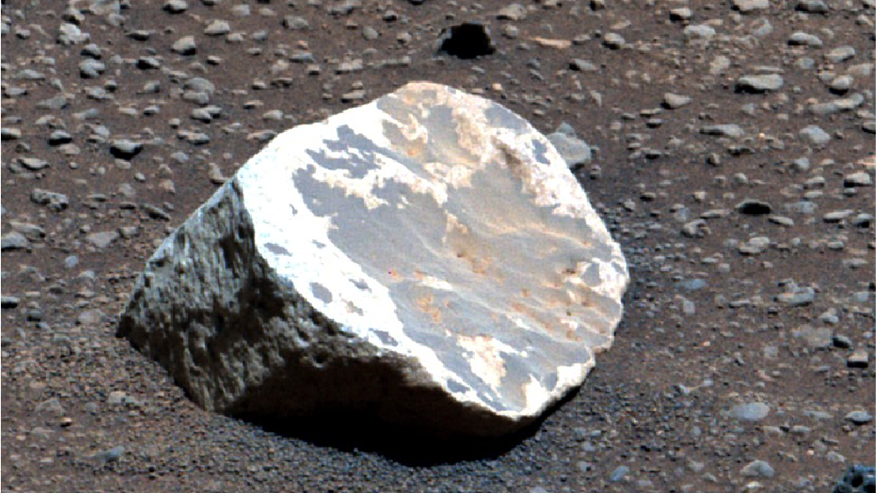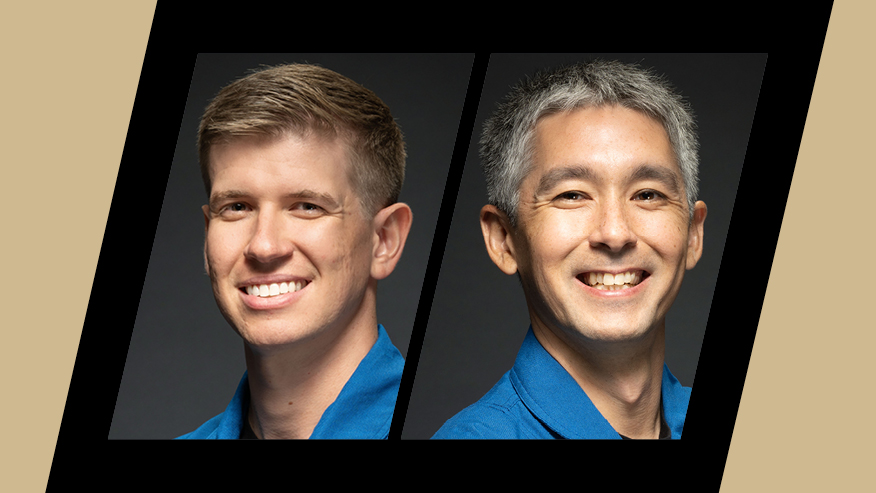Stellar forensics: Clearest ever look at Cassiopeia A sheds light into the heart of an exploding star
JWST image and data give researchers insight into the nature of explosions, Cassiopeia A’s progenitor star and the difficult-to-study interstellar medium

Danny Milisavljevic’s Year 1 research on the James Webb Space Telescope led to his new detailed image of stellar remnant Cassiopeia A in which infrared light is translated into visible-light wavelengths. (Purdue University photo)
WEST LAFAYETTE, Ind. —
Images of stars released to the public, like the new image of Cassiopeia A revealed last month, fire the public’s imagination and kindle wonder in the breadth and beauty of the universe. But those images are more than just awe-inspiring art — they are treasure troves of priceless scientific information.
By taking photos of the stellar remnant using a range of tools and filters on the James Webb Space Telescope (JWST), astronomers are getting their clearest look ever at Cassiopeia A. Astronomer and star expert Danny Milisavljevic (pronounced mili-sahv-la-vich), an associate professor of physics and astronomy in Purdue University’s College of Science, led an enormous international team of researchers on a JWST Year 1 project to study the supernova remnant.
“Previous images of Cassiopeia A, one of the most well-studied and important supernova remnants, were beautiful and staggering, but they only scratched the surface,” Milisavljevic said. “They showed the brightest emissions. We are interested more in the gas that’s closest to where the explosion originally took place, and what it can tell us.”
Additional Information
False colors, true insights
When a supernova explodes, it sends out a powerful shock wave into the environment, gas and dust that was shed by the star before it exploded. The gas is cool — not just cool as in amazing and fascinating, though it is, but also cool in temperature compared to the bright emissions. The dust and other material Milisavljevic and his team are focusing on are incredibly complex, the result of an array of conflicting forces that scientists still do not completely understand.
The newest image of supernova remnant Cassiopeia A uses different colors to designate different wavelengths of energy.
“With some clever manipulation of the filters, we are able to look closely at the gas inside Cas A,” Milisavljevic said. “We’ve never had this kind of look at an exploded star before. This weblike network of gas, these patterns and insights, these are all new discoveries. We are trying to figure out what is going on in the center of Cas A, the heart of the explosion.”
The flashy part of Cassiopeia A is like a firework explosion — bright, eye-catching and dynamic. But the dust clouds and their movement, like the smoke left behind by a firework, are complex and communicate new information about the original star, its fatal explosion and the environment that surrounded the supernova. Using the new tools and abilities of JWST, the team can mask out the brightly shining parts of the star and focus more on the dust.
“The bright ring that draws your eye on images of Cassiopeia A, that’s the result of shocks, like when a rock drops into water,” Milisavljevic said. “That shocked material is very bright in ultraviolet and X-ray light, and it shines photons inside the cloud of gas that hasn’t yet been shocked. That’s why we can see it in the infrared — because of this rain of X-ray and UV photons shining and illuminating all this gas that has been hidden from view.”
Astronomers have spent decades trying to figure out what kind of star existed before it turned into supernova Cassiopeia A. To do that, they needed new, stronger tools and the ability to peer into the heart of the explosion.
Stronger, closer, better
When Galileo first looked closely at the planet Saturn in 1610, he famously described it as having ears. Decades later, with advances to telescopes, Huygens was able to resolve the ears into rings around the planet. And much, much later, in 1856, Scottish physicist James Maxwell deduced that the rings weren’t solid at all but were composed of innumerable shards of rock and ice.
That same advancing of knowledge, along with technical telescope improvements, is echoed in JWST’s discoveries.
“We have had glimpses of the heart of the explosion before,” Milisavljevic said. “It was shown faintly in images from Spitzer, and HST (Hubble Space Telescope) shows it a little bit. Additional information came from Chandra and NuSTAR telescopes sensitive to X-ray light. I wrote a paper about modeling it in 3D years ago. But Webb has this spectacular ability to tease out all the gas that is there. For the first time, we’ll be able to connect the relatively bright gas located along the periphery of the remnant with the faint gas inside the explosion that only Webb can see.”
For instance, an enigmatic structure dubbed the “Green Monster” for its resemblance to the eponymous green wall in Fenway Park baseball stadium puzzled and dazzled the world since NASA’s first image release in April 2023. However, careful analysis by Milisavljevic’s team, supported by observations made by Chandra, demonstrated that this Green Monster was actually gas in the foreground, located far away from the explosion center. Like a rogue photobomber in a vacation photo, the Green Monster grabbed attention but was not the intended target. Using special filtering techniques, scientists were able to digitally remove the Green Monster and successfully examine the extremely faint light emanating from deepest layers of the exploded star, as they had originally set out to do.
Understanding the nature of the explosion will help astronomers answer long-held questions about how stars live and how they die. How the core of the star collapsed physically, and why it did, will answer important questions about the composition of stars and how they change and evolve.
Time machines and light echoes
What astronomers really want, of course, is faster-than-light travel, time machines, and endless time and resources to personally inspect the stars. Absent those, however, JWST is a pretty good substitute. The laws of physics themselves, in fact, have acted as a sort of time machine to show astronomers what the supernova remnant looked like earlier in its history.
In the corner of the image of Cassiopeia A, something that looks like a smaller version of the supernova remnant itself appears. Dubbed “Baby Cas A,” it is actually a light echo located about 170 light-years behind Cassiopeia A. Located about 11,000 light-years away, Cassiopeia A exploded 340 years ago from Earth’s point of view. Baby Cas A formed as the light from the explosion hit dust about 170 years behind Cas A and then bounced forward again to hit JWST’s mirrors.
Watching how the star explodes and how light and matter move outward gives astronomers insight into the very nature of space itself between the stars. As hard as it is to study balls of gas burning billions of miles away, at least they’re lit up and visible against the darkness of space. Studying that dark space, the space between the stars, is exponentially more difficult, but as vitally important to understanding how the universe, and humanity’s planet within it, developed and evolve.
“This round of papers, this round of discoveries, are incredibly exciting,” Milisavljevic said. “We are highlighting what we see as some of the most exciting initial results, the kind that immediately pop out of the dataset. It is the first reconnaissance. I anticipate many exciting scientific discoveries still to come from these data over the next several years.”
This research was funded in part by the National Science Foundation.
About Purdue University
Purdue University is a public research institution with excellence at scale. Ranked among top 10 public universities and with two colleges in the top four in the United States, Purdue discovers and disseminates knowledge with a quality and at a scale second to none. More than 105,000 students study at Purdue across modalities and locations, with 50,000 in person on the West Lafayette campus. Committed to affordability and accessibility, Purdue’s main campus has frozen tuition 13 years in a row. See how Purdue never stops in the persistent pursuit of the next giant leap, including its first comprehensive urban campus in Indianapolis, the new Mitchell E. Daniels, Jr. School of Business, and Purdue Computes, at https://www.purdue.edu/president/strategic-initiatives.
Writer/Media contact: Brittany Steff bsteff@purdue.edu
Source: Dan Milisavljevic, dmilisav@purdue.edu



